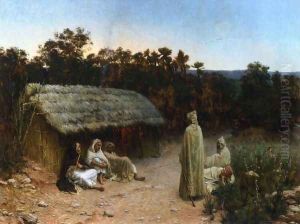Paul (Jean Baptiste) Lazerges Paintings
Paul Jean Baptiste Lazerges was a French Orientalist painter born on July 29, 1845, in Paris, France. He was known for his depictions of North African landscapes and scenes of daily life, which were a result of the fascination with Orientalist themes prevalent among European artists in the 19th century. Lazerges grew up during a period when Orientalism was in vogue, largely due to the French colonization of North African territories and the expanding reach of the Ottoman Empire.
Lazerges studied at the École des Beaux-Arts in Paris, which was the premier art institution in France at the time. He was a student of artists like Alexandre Cabanel and Eugène Fromentin. Fromentin, in particular, was influential in the development of Orientalist painting, and his impact is evident in Lazerges' work. Paul Lazerges exhibited at the Paris Salon, the official art exhibition of the Académie des Beaux-Arts, and his works were well received, earning him medals in 1873 and 1882.
His travels in North Africa, especially Algeria, which was a French colony then, provided him with a wealth of subjects for his paintings. Lazerges captured the light, architecture, and the inhabitants of the region with a romanticized perspective that was typical of Orientalist art. His compositions often included bustling marketplaces, serene landscapes, and genre scenes that highlighted local customs and costumes.
Despite his focus on Orientalist themes, Lazerges also produced religious works and was known for his skill as a portraitist. He worked in various media, including watercolor and oil paint, and his style was characterized by detailed realism and a vivid yet harmonic color palette.
Paul Jean Baptiste Lazerges passed away in 1902. His works continue to be appreciated for their historical value and artistic merit. They provide insight into the Orientalist movement and the Western perception of North Africa during the 19th century. Lazerges' paintings can be found in various museums and private collections, contributing to the understanding of a complex and often romanticized era of cultural intersection.
